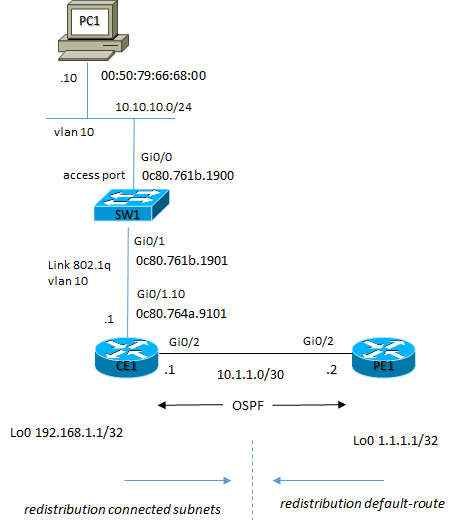ospf default-information originate always default-route example config
23.01 2020 | by massimilianoQuando abbiamo la necessità di inviare una default route con ospf attraverso il comando ospf default-information dobbiamo considerare i seguenti […]
https://www.ingegnerianetworking.com/wp-content/uploads/2020/01/default-information-ospf-example1-863.png
Quando abbiamo la necessità di inviare una default route con ospf attraverso il comando ospf default-information dobbiamo considerare i seguenti aspetti:
ARCHITETTURA di RIFERIMENTO:

Example Config:
CE1#
router ospf 1
router-id 192.168.1.1
redistribute connected subnets
!
PE1#
router ospf 1
router-id 1.1.1.1
default-information originate
Verifica tabella di routing (con il comando default-information originate “senza always”)
PE1#show ip route
Gateway of last resort is not set
1.0.0.0/32 is subnetted, 1 subnets
C 1.1.1.1 is directly connected, Loopback0
10.0.0.0/8 is variably subnetted, 3 subnets, 3 masks
C 10.1.1.0/30 is directly connected, GigabitEthernet0/2
L 10.1.1.2/32 is directly connected, GigabitEthernet0/2
O E2 10.10.10.0/24 [110/20] via 10.1.1.1, 00:14:43, GigabitEthernet0/2 # corretto
192.168.1.0/32 is subnetted, 1 subnets
O E2 192.168.1.1 [110/20] via 10.1.1.1, 00:14:43, GigabitEthernet0/2
CE1#show ip route
Gateway of last resort is not set # questo è il risultato “sbagliato”
10.0.0.0/8 is variably subnetted, 4 subnets, 3 masks
C 10.1.1.0/30 is directly connected, GigabitEthernet0/2
L 10.1.1.1/32 is directly connected, GigabitEthernet0/2
C 10.10.10.0/24 is directly connected, GigabitEthernet0/1.10
L 10.10.10.1/32 is directly connected, GigabitEthernet0/1.10
192.168.1.0/32 is subnetted, 1 subnets
C 192.168.1.1 is directly connected, Loopback0
Per ricevere una default route è necessario che lato PE ci sia una routes di default nella sua tabella RIB affinchè sia possibile annunciarla al CE1.
PE1(config)#ip route 0.0.0.0 0.0.0.0 null 0
CE1#show ip route
Gateway of last resort is 10.1.1.2 to network 0.0.0.0
O*E2 0.0.0.0/0 [110/1] via 10.1.1.2, 00:00:54, GigabitEthernet0/2
10.0.0.0/8 is variably subnetted, 4 subnets, 3 masks
C 10.1.1.0/30 is directly connected, GigabitEthernet0/2
L 10.1.1.1/32 is directly connected, GigabitEthernet0/2
C 10.10.10.0/24 is directly connected, GigabitEthernet0/1.10
L 10.10.10.1/32 is directly connected, GigabitEthernet0/1.10
192.168.1.0/32 is subnetted, 1 subnets
C 192.168.1.1 is directly connected, Loopback0
Se non vogliamo inserire una static route in null 0, possiamo invece utilizzare il comando ospf default-information originate always:
PE1(config)#no ip route 0.0.0.0 0.0.0.0 null 0
!
router ospf 1
router-id 1.1.1.1
default-information originate always
!
CE1#show ip route
Gateway of last resort is 10.1.1.2 to network 0.0.0.0
O*E2 0.0.0.0/0 [110/1] via 10.1.1.2, 00:01:14, GigabitEthernet0/2
10.0.0.0/8 is variably subnetted, 4 subnets, 3 masks
C 10.1.1.0/30 is directly connected, GigabitEthernet0/2
L 10.1.1.1/32 is directly connected, GigabitEthernet0/2
C 10.10.10.0/24 is directly connected, GigabitEthernet0/1.10
L 10.10.10.1/32 is directly connected, GigabitEthernet0/1.10
192.168.1.0/32 is subnetted, 1 subnets
C 192.168.1.1 is directly connected, Loopback0